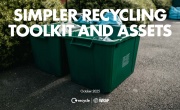Confidence building
Consultation is currently taking place on a mandatory MRF Code of Practice, which proposes a sampling regime to measure material quality, an issue of concern to UK reprocessors. UPM’s Craig Robinson reflects on the challenge

Craig Robinson is Director, RCP Market & Operations – UK & Ireland at UPM-Kymmene www.upm.com
At Shotton, we have a unique perspective on the issue of material quality. It’s the only place in the UK integrating an MRF with high-quality newsprint manufacturing.
For a long time I’ve believed that the issue of material quality impacts on all high-quality manufacturing companies, no matter what
sector they represent. This is true for all the major players in the key recyclate sectors of paper, cardboard, plastics, metals and glass. We all represent the circular economy, promote real sustainability, create green jobs and face the same issues.
I also believe that the UK recyclables market supply chain is, in some instances, inefficient and disconnected. All players in the market – from local authorities right through to reprocessors – must understand their role in it. Recognising our interdependency is pivotal to realising growth from the value chain over the long term.
In principle, I welcome the development of the MRF Code of Practice (CoP) and support the current proposal that its introduction becomes mandatory. With regard to the testing of input material, the UPM MRF has a dedicated testing facility and takes samples of approximately 250 kilogrammes (kg). The CoP favours sample sizes of 20kg, but this will be problematic. We opt for a larger sample because it minimises composition variability that can be caused by heavier items.
It’s natural that the industry is concerned about the costs of testing: who is going to pay for this and how it will be achieved? Our experience is that both the tangible and intangible benefits outweigh the costs, for our suppliers and customers, as well as us.
A robust testing regime helps to improve MRF process efficiency and reduce residual contamination. Moving back up the supply chain, it can assist councils with their compliance and inform targeted marketing campaigns to improve capture rates.
However, perhaps the greatest benefit of a robust sampling regime is it can give confidence to your end customer. You are able to demonstrate to a reprocessor that you have a clear and demonstrable focus on their quality needs.
 This article was taken from Issue 70
This article was taken from Issue 70Organisations that have a formalised quality management system should include the testing and reporting requirements of the CoP within scope. These systems and the CoP are natural bedfellows; why reinvent the wheel? This will enable the self-determined processes, procedures, and continuous improvement plans to be managed and evidenced. External quality management auditors would verify system conformity, but are not necessarily best placed to recognise whether MRF output meets a material quality standard for the industry. It would require the expertise of a technical auditor, such as the Environment Agency, to verify this.
I also urge caution on the debate about reporting of data and how transparent that should be. Generally, those in the public sector would like to see more of this on the premise that more data informs better choices, but commercial organisations want to retain some information to preserve value and/or market differentiation. So far, not enough consideration has yet been given to the legal and commercial confidential aspects of data management and disclosure, especially the permission this requires from the MRF’s partners.
Interested parties are clear about what they want to happen, but not necessarily on how to achieve it. Any programme of disclosure needs to establish what data is to be included and excluded, recognising which stakeholders would benefit.
For a real step change in recyclable material quality to be realised, it requires the whole supply chain to be united and resolute in driving quality standards forward. Local authorities should look to incorporate demonstrable compliance with the conditions of the CoP along with other best practice when procuring collection and sorting services.
Ultimately, it is the end customer that is the final arbiter of quality gauged against the appropriate industry quality standard. 






